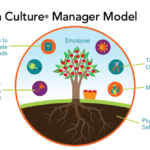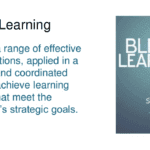This website uses cookies so that we can provide you with the best user experience possible. Cookie information is stored in your browser and performs functions such as recognising you when you return to our website and helping our team to understand which sections of the website you find most interesting and useful.
How to Create an Effective Learning Program (3 in 3 part series)

This blog post is a 3-part series. Here's Part 1 and Part 2.
To be a great learning leader, you need to run your department like a business. You need to listen to your customers (the other functions and leaders in your org), design solutions to meet their needs (even ones they don’t know they have yet), and then deliver your programs so they achieve the desired results.
This means that in addition to thinking like a learning pro, you also need to think like a CEO.
Knowing a lot about learning and instructional design doesn’t make you a marketing, data analysis, or financial planning whiz. And yet all these skills will be crucial as you work to stay ahead of the needs of your organization.
Regardless of your organization’s size, as your learning department inevitably grows and moves through the stages of the Greiner Curve you’ll eventually hire leaders to run the various functions, create systems and processes, battle red tape, and explore alliances.
To successfully deliver great learning to your talent, you’ll need to have the following:
1. A process for serving as a strategic partner to your business
Decide who serves as consultants to each function and how you’ll track their needs and requests. It’s not uncommon that similar issues start to crop up across the organization, so if Sales asks for a change management solution and Engineering does too, you’ll want to coordinate those requests and resources.
2. An instructional design team
To create amazing learning solutions, using best practices for helping adult professionals grow, use professional and experienced instructional designers. I always hire people who have experience facilitating live audiences because seeing how people actually learn makes them better at designing the right solutions. In addition, consider other formats you might want including online learning, webinars, and adaptive technology.
3. A project management process
Keep track of which learning solutions you’re creating for which audiences. As projects get bigger, you’ll need to think about estimating person-hours, tracking progress through various teams, and managing the various assets like presentation decks, exercises, and curated content.
4. A marketing plan
Yep, it’s a must. It’s not enough to just build great learning solutions— you’ve got to get the word out so your people know what you offer and how to use it. You’ll find that you market the value of learning to every level, from senior executives to frontline employees, so be sure you bring marketing expertise to your efforts.
Messaging that starts with a simple email announcement and a website might evolve as a company grows until you need global announcements targeted to multiple channels and audiences and localized to different countries. As these needs grow more complex you may need an internal communications team who monitors compliance with brand requirements.
5. A team of trained facilitators
Once people are enrolled, someone will need to deliver or facilitate the learning solution. Do you use in-house facilitators or external ones? How do they get trained on the content and who does quality control? Create something that allows you to be confident that your audience is getting a flawless and positive experience.
6. A learning management system
You need a way for people to enroll in your offerings and for dealing with the post-event details like evaluations and post-even assignments.
7. A process for evaluating your learning solutions
To demonstrate the value of your offerings, you’ll need to collect data so you can assess the effectiveness and make improvements. I encourage you to learn more about Jack Phillips work on levels of evaluation and how to calculate ROI.
Data analytics will help you evaluate all kinds of issues: enrollment patterns and demand, attendance, effectiveness, and so on. This includes both tracking online usage, such as page views and clicks, and also assesses comprehension and skill mastery. It’s also helpful to identify where you are on the Greiner Curve, to sunset certain solutions at the right time and pivot to investing in solutions for the next phase. And it’s important to stay up-to-date on legal implications of contracts, licenses, and copyright issues.
This may seem like a lot—and it is. But remember, you’re running a successful business! Fortunately, these shifts occur gradually, but to get prepared, , take advantage of the many automated systems and processes available for purchase. And stay connected to the L&D industry through professional associations, publications, and conferences, for access to the latest and greatest options.
Related Blogs
JOIN OUR COMMUNITY
Be the first to know of Dr. Britt Andreatta's latest news and research.






